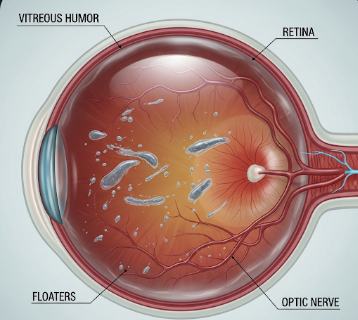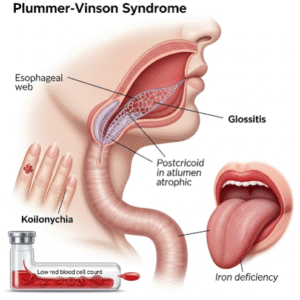Overview
Eye floaters (Myodesopsias) are small specks, threads, or cobweb-like shapes that drift across the visual field. They are caused by tiny clumps of gel or cells inside the vitreous humor, the clear gel that fills the eye. Floaters are most noticeable when looking at a bright, plain background, such as a clear sky or a white wall. In Korea, ophthalmology clinics provide evaluation and treatment options for eye floaters, ensuring that underlying conditions such as retinal tears or detachments are promptly detected.
Highlights:
➤ Visual phenomena floating in the field of vision – Small dots, lines, or cobwebs
➤ Common with aging – Often due to changes in the vitreous humor
➤ May indicate serious eye conditions – Requires evaluation to rule out retinal issues
Key Facts
➤ Prevalence: Floaters are very common, particularly in adults over 50; nearly everyone experiences them at some point
➤ Age affected: Can occur at any age, though more frequent with aging
➤ Gender: Equally affects males and females
➤ Impact: Usually benign, but sudden increase in floaters can indicate retinal tear or detachment and may threaten vision
What is Eye Floaters (Myodesopsias)?
Eye floaters are tiny shadows cast on the retina by clumps of vitreous gel or cellular debris floating in the vitreous humor. Key characteristics include:
- Appearance: Small spots, threads, or squiggly shapes moving with eye movement
- Movement: Floaters drift as the eye moves, often disappearing when the eye is still
- Visibility: Most noticeable against bright or uniform backgrounds
Highlights:
➤ Usually benign and age-related – Caused by vitreous degeneration
➤ Sudden onset may signal retinal problems – Requires immediate evaluation
➤ Floaters move with eye movements – They are shadows inside the eye, not on the surface
What Symptoms Are Related to Eye Floaters?
➤ Small moving spots in vision – Black or gray specks, threads, or cobweb-like shapes
➤ Flashes of light (photopsia) – May indicate retinal traction
➤ Blurry areas – Caused by shadows on the retina
➤ Sudden increase in floaters – Red flag for retinal tear or detachment
➤ Peripheral vision involvement – Usually floaters are central, but may appear peripherally
➤ Difficulty reading or focusing – If floaters are dense or numerous
Highlights:
➣ Symptoms often worsen with age or vitreous changes
➣ Sudden or severe floaters require urgent ophthalmologic evaluation
What Causes / Possible Causes
➤ Age-related vitreous changes: Liquefaction and clumping of the vitreous gel
➤ Posterior vitreous detachment (PVD): Separation of vitreous from the retina
➤ Retinal tears or detachment: Floaters accompanied by flashes of light
➤ Inflammation inside the eye (uveitis): Can produce cellular debris in the vitreous
➤ Bleeding in the eye: From diabetic retinopathy or trauma
➤ Eye injuries or surgeries: Trauma or post-surgical debris in vitreous humor
Highlights:
➣ Causes range from benign age-related changes to urgent retinal conditions
➣ Identifying the underlying cause is essential to prevent vision loss
When Should I See My Doctor?
➤ Sudden increase in floaters – Especially when accompanied by light flashes
➤ Loss of peripheral vision or shadow in vision – Could indicate retinal detachment
➤ Floaters following eye trauma – Immediate assessment needed
➤ Persistent or worsening floaters – To monitor for retinal complications
➤ History of retinal disease or high myopia – Increased risk for retinal problems
Highlights:
➣ Early consultation at a Korean ophthalmology clinic ensures detection of serious conditions
➣ Timely intervention prevents irreversible vision loss
Care and Treatment
➤ Observation: Most floaters are benign and do not require treatment
➤ Laser vitreolysis: Laser treatment to break up dense floaters in selected cases
➤ Vitrectomy: Surgical removal of vitreous gel for severe or vision-impairing floaters
➤ Lifestyle and monitoring: Regular eye exams, especially for at-risk individuals
➤ Symptomatic management: Adjusting lighting, reducing eye strain, and coping strategies
Highlights:
➣ Treatment is usually reserved for significant visual impairment
➣ Monitoring prevents complications and ensures retinal health
Treatment Options in Korea
Medical Treatments:
➤ Comprehensive eye exams: Evaluation of floaters and retinal health
➤ Laser vitreolysis: Non-invasive procedure for selected symptomatic floaters
➤ Pharmacologic support: Eye drops for underlying inflammation if present
Advanced Procedures:
➤ Vitrectomy: Surgical removal of vitreous for severe cases
➤ Retinal imaging and OCT: Monitoring for retinal tears or detachment
➤ Follow-up care: Regular check-ups to ensure vision stability and safety
Rehabilitation & Follow-Up Care:
➤ Patient education on symptom monitoring, warning signs, and visual hygiene
➤ Lifestyle adaptations to reduce eye strain and enhance visual comfort
➤ Multidisciplinary collaboration for diabetic or high-risk patients
Highlights:
➣ Korean eye centers provide advanced diagnostics, laser therapy, and surgical management
➣ Early evaluation and tailored interventions prevent serious complications and maintain vision













